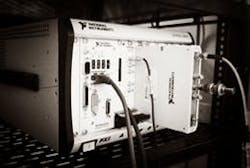Random-number generator gets its input from quantum vacuum fluctuations
Canberra, Australia--Researchers at The Australian National University (ANU) are generating true random (not quasirandom) numbers from a single-mode laser setup that makes broadband measurements of the vacuum field.1 And, based on this setup, they have a website that anyone who needs live random numbers can access.
The vacuum is actually an extent of space that has virtual subatomic particles spontaneously and randomly appearing and disappearing. The setup ANU makes measurements of the vacuum field contained in radio-frequency sidebands of a laser; the resulting photocurrents are then transformed by an algorithm into a string of random numbers that are generated at up to 2 Gbit/s.
“While it has always been thought to be an annoyance that engineers and scientists would like to circumvent, we instead exploited this vacuum noise and used it to generate random numbers,” said ANU professor Ping Koy Lam.
Random number generation has many uses in information technology. Global climate prediction, air traffic control, electronic gaming, encryption, and various types of computer modeling all rely on the availability of unbiased, truly random numbers. To date, most random-number generators are based on computer algorithms. Although computer-generated random numbers can be useful, knowing the input conditions to the algorithm will lead to predictable and reproducible output, thus making the numbers not truly random.
To overcome this issue, random number generators relying on inherently random physical processes, such as radioactive decay and chaotic behavior in circuits, have been developed. The ANU random-number-generation process is the fastest true-random-number generation scheme yet.
“Vacuum noise is one of the ultimate sources of randomness because it is intrinsically broadband and its unpredictability is guaranteed by quantum theory," says Thomas Symul, another one of the researchers. "Because of this, we are able to generate billions of random numbers every second.”
The random number generator is online and can be accessed from anywhere at anytime around the world at http://photonics.anu.edu.au/qoptics/Research/qrng.php . Anyone who downloaded live random numbers from the ANU website will get a fresh and unique sequence of numbers that is different from all other users.
In collaboration with QuintessenceLabs, an Australian quantum-technology company, the ANU team is now looking into commercializing the system. The team hopes to have this technology miniaturized down to the size of a thumb drive.
REFERENCE:
1. T. Symul et al., Applied Physics Letters, Vol. 98, No. 23, p. 231103 (2011).
About the Author
John Wallace
Senior Technical Editor (1998-2022)
John Wallace was with Laser Focus World for nearly 25 years, retiring in late June 2022. He obtained a bachelor's degree in mechanical engineering and physics at Rutgers University and a master's in optical engineering at the University of Rochester. Before becoming an editor, John worked as an engineer at RCA, Exxon, Eastman Kodak, and GCA Corporation.

